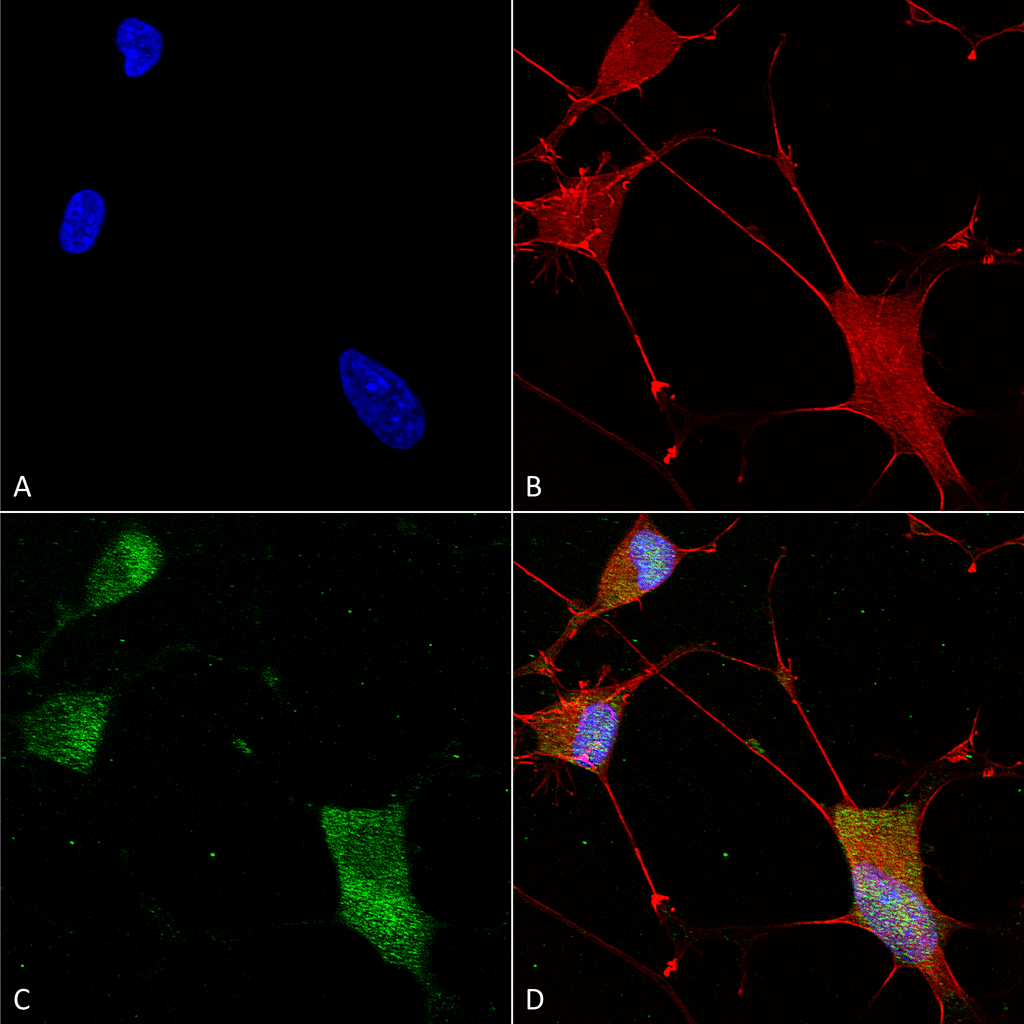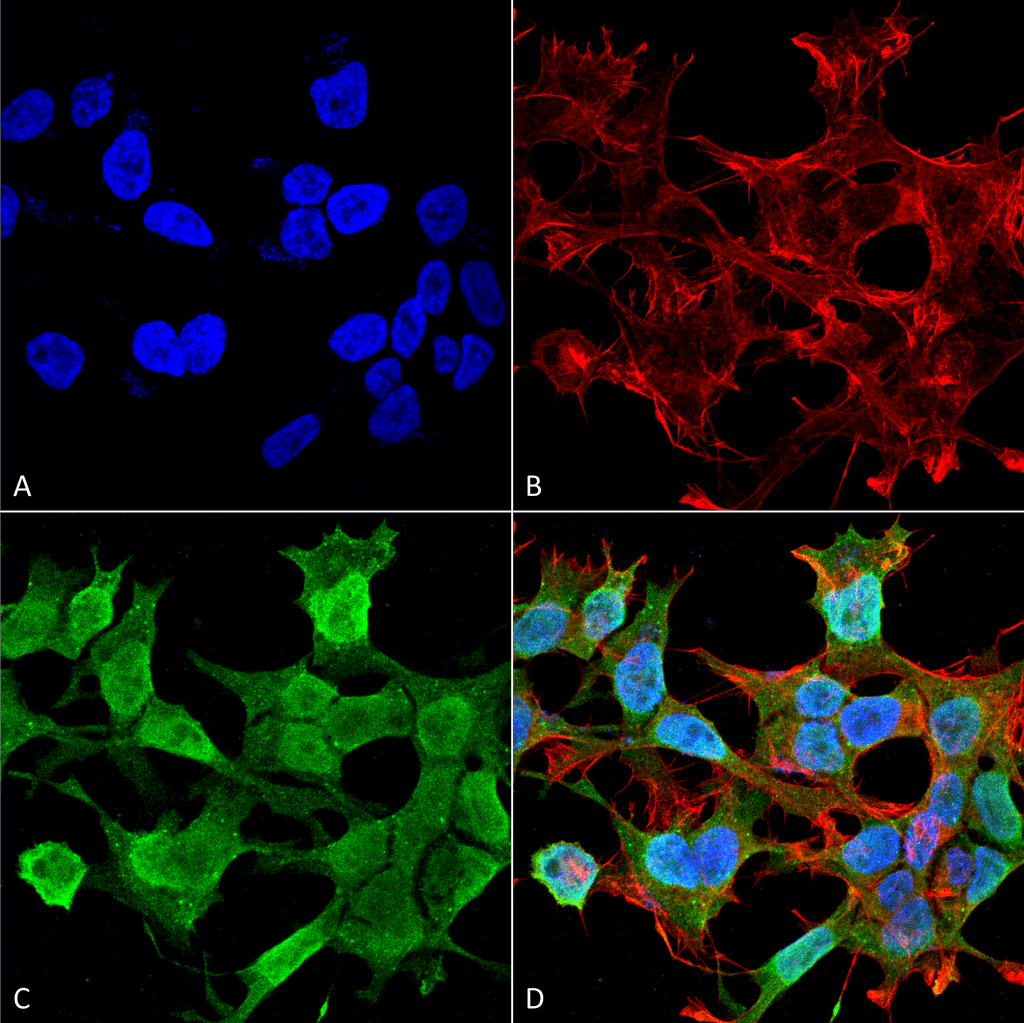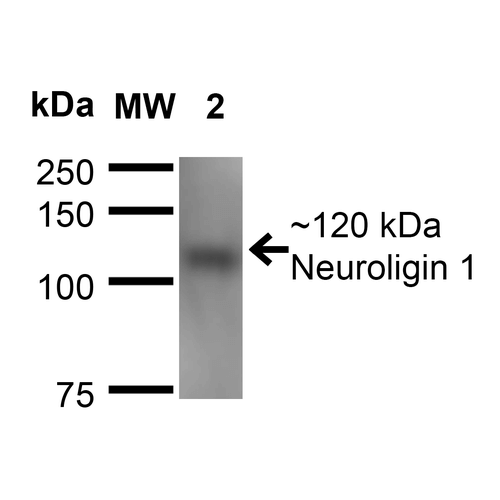Anti-Neuroligin-1 Antibody (56551)
Anti-Neuroligin-1 Antibody (56551)
Product No.: 56551
- -
- -
Clone S97A-31 Target Neuroligin-1 Formats AvailableView All Product Type Monoclonal Alternate Names Neuroligin I Isotype Mouse IgG1 Applications ICC , IF , IHC , WB |
Data
 Immunocytochemistry/Immunofluorescence analysis using Mouse Anti-Neuroligin 1 Monoclonal Antibody, Clone S97A-31 (56551). Tissue: Neuroblastoma cells (SH-SY5Y). Species: Human. Fixation: 4% PFA for 15 min. Primary Antibody: Mouse Anti-Neuroligin 1 Monoclonal Antibody (56551) at 1:100 for overnight at 4°C with slow rocking. Secondary Antibody: AlexaFluor 488 at 1:1000 for 1 hour at RT. Counterstain: Phalloidin-iFluor 647 (red) F-Actin stain; Hoechst (blue) nuclear stain at 1:800, 1.6mM for 20 min at RT. (A) Hoechst (blue) nuclear stain. (B) Phalloidin-iFluor 647 (red) F-Actin stain. (C) Neuroligin 1 Antibody (D) Composite.
Immunocytochemistry/Immunofluorescence analysis using Mouse Anti-Neuroligin 1 Monoclonal Antibody, Clone S97A-31 (56551). Tissue: Neuroblastoma cells (SH-SY5Y). Species: Human. Fixation: 4% PFA for 15 min. Primary Antibody: Mouse Anti-Neuroligin 1 Monoclonal Antibody (56551) at 1:100 for overnight at 4°C with slow rocking. Secondary Antibody: AlexaFluor 488 at 1:1000 for 1 hour at RT. Counterstain: Phalloidin-iFluor 647 (red) F-Actin stain; Hoechst (blue) nuclear stain at 1:800, 1.6mM for 20 min at RT. (A) Hoechst (blue) nuclear stain. (B) Phalloidin-iFluor 647 (red) F-Actin stain. (C) Neuroligin 1 Antibody (D) Composite. Immunocytochemistry/Immunofluorescence analysis using Mouse Anti-Neuroligin 1 Monoclonal Antibody, Clone S97A-31 (56551). Tissue: Neuroblastoma cell line (SK-N-BE). Species: Human. Fixation: 4% Formaldehyde for 15 min at RT. Primary Antibody: Mouse Anti-Neuroligin 1 Monoclonal Antibody (56551) at 1:100 for 60 min at RT. Secondary Antibody: Goat Anti-Mouse ATTO 488 at 1:100 for 60 min at RT. Counterstain: Phalloidin Texas Red F-Actin stain; DAPI (blue) nuclear stain at 1:1000, 1:5000 for 60min RT, 5min RT. Localization: Cell Membrane, Nucleus. Magnification: 60X. (A) DAPI (blue) nuclear stain. (B) Phalloidin Texas Red F-Actin stain. (C) Neuroligin 1 Antibody. (D) Composite.
Immunocytochemistry/Immunofluorescence analysis using Mouse Anti-Neuroligin 1 Monoclonal Antibody, Clone S97A-31 (56551). Tissue: Neuroblastoma cell line (SK-N-BE). Species: Human. Fixation: 4% Formaldehyde for 15 min at RT. Primary Antibody: Mouse Anti-Neuroligin 1 Monoclonal Antibody (56551) at 1:100 for 60 min at RT. Secondary Antibody: Goat Anti-Mouse ATTO 488 at 1:100 for 60 min at RT. Counterstain: Phalloidin Texas Red F-Actin stain; DAPI (blue) nuclear stain at 1:1000, 1:5000 for 60min RT, 5min RT. Localization: Cell Membrane, Nucleus. Magnification: 60X. (A) DAPI (blue) nuclear stain. (B) Phalloidin Texas Red F-Actin stain. (C) Neuroligin 1 Antibody. (D) Composite. Western Blot analysis of Mouse Brain Membrane showing detection of ~120 kDa Neuroligin 1 protein using Mouse Anti-Neuroligin 1 Monoclonal Antibody, Clone S97A-31 (56551). Lane 1: Molecular Weight Ladder. Lane 2: Mouse Brain Membrane. Load: 15 µg. Block: 2% BSA and 2% Skim Milk in 1X TBST. Primary Antibody: Mouse Anti-Neuroligin 1 Monoclonal Antibody (56551) at 1:200 for 16 hours at 4°C. Secondary Antibody: Goat Anti-Mouse IgG: HRP at 1:1000 for 1 hour RT. Color Development: ECL solution for 6 min in RT. Predicted/Observed Size: ~120 kDa.
Western Blot analysis of Mouse Brain Membrane showing detection of ~120 kDa Neuroligin 1 protein using Mouse Anti-Neuroligin 1 Monoclonal Antibody, Clone S97A-31 (56551). Lane 1: Molecular Weight Ladder. Lane 2: Mouse Brain Membrane. Load: 15 µg. Block: 2% BSA and 2% Skim Milk in 1X TBST. Primary Antibody: Mouse Anti-Neuroligin 1 Monoclonal Antibody (56551) at 1:200 for 16 hours at 4°C. Secondary Antibody: Goat Anti-Mouse IgG: HRP at 1:1000 for 1 hour RT. Color Development: ECL solution for 6 min in RT. Predicted/Observed Size: ~120 kDa. - -
- -
Antibody DetailsProduct DetailsReactive Species Human ⋅ Mouse ⋅ Rat Host Species Mouse Immunogen Fusion protein corresponding to aa 718-843 (cytoplasmic C-terminus) of rat Neuroligin- 1, accession no. Q62765). This sequence is 99 Product Concentration 1.0 mg/ml Formulation PBS, pH 7.4, 0.1% sodium azide, 50% glycerol. State of Matter Liquid Product Preparation Purified by Protein G affinity chromatography Storage and Handling This product is stable for at least one (1) year at -20°C. Regulatory Status For in vitro investigational use only. Not intended for therapeutic or diagnostic procedures. Country of Origin USA Shipping Next Day 2-8°C Applications and Recommended Usage? Quality Tested by Leinco Immunoblotting: use at 1-5ug/mL. A band of ~120kDa is detected.
Immunofluorescence: use at 10ug/mL. These are recommended concentrations. Endusers should determine optimal concentrations for their applications. Each investigator should determine their own optimal working dilution for specific applications. See directions on lot specific datasheets, as information may periodically change. DescriptionDescriptionSpecificity This antibody recognizes human, mouse, and rat Neuroligin-1. It does not cross-react with other Neuroligins. Background Neuroligin-1 is a neuronal cell surface protein and member of the type-B carboxylesterase/lipase family. It is a necessary component in the maturation of excitatory synapses, it participates in regulation of synaptic plasticity, and it is important in the development of long- term memory in adult mammalian amygdala. It's participation in cell-cell interactions may occur through assembly of intracellular junctions by binding of beta-neurexins. In nervous system tissue, Neuroligin-1 is observed primarily in neurons and in the spinal cord. Function Cell surface protein involved in cell-cell-interactions via its interactions with neurexin family members. Plays a role in synapse function and synaptic signal transmission, and probably mediates its effects by recruiting and clustering other synaptic proteins. May promote the initial formation of synapses, but is not essential for this. In vitro, triggers the de novo formation of presynaptic structures. May be involved in specification of excitatory synapses. Required to maintain wakefulness quality and normal synchrony of cerebral cortex activity during wakefulness and sleep (By similarity). The protein is involved in nervous system development. {UniProtKB:Q99K10, PubMed:15620359, PubMed:9325340}. NCBI Gene Bank ID UniProt.org Research Area Neuroscience References & CitationsTechnical ProtocolsCertificate of Analysis |


